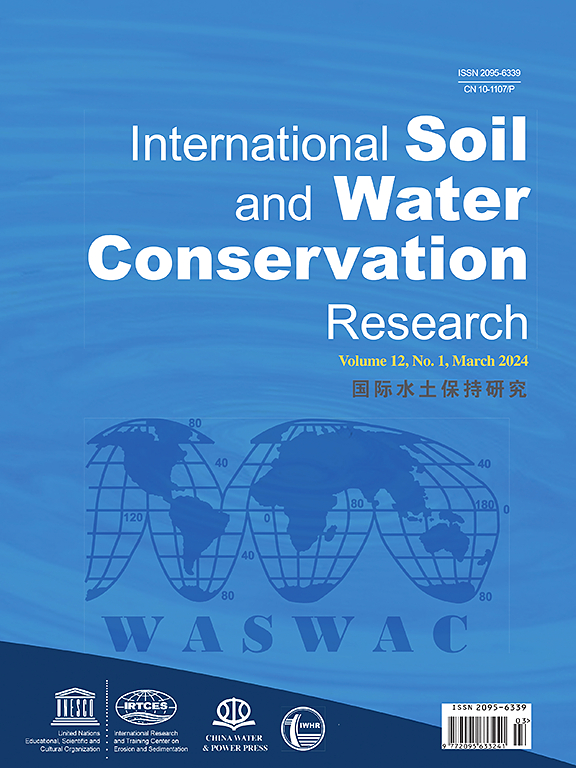流域尺度上土壤有机碳的三维时空变化及其影响因素
IF 7.3
1区 农林科学
Q1 ENVIRONMENTAL SCIENCES
International Soil and Water Conservation Research
Pub Date : 2024-05-16
DOI:10.1016/j.iswcr.2024.05.001
引用次数: 0
摘要
土壤有机碳(SOC)的变化跨越三个维度。然而,对不同土壤深度 SOC 时空变化影响因素的定量分析却很少。本研究利用 20 世纪 80 年代和 2010 年代在洞庭湖流域开展的两次土壤调查的遗留数据,采用随机森林模型生成三维 SOC 地图。通过相关性分析和置换重要性分析,我们确定了驱动 SOC 时空变化的主要因素。结果表明,2010 年代洞庭湖流域 1 米深以内的 SOC 储量约为 2.95 Pg,自 20 世纪 80 年代以来平均每年增加 0.0047 Pg C。平均 SOC 含量较高的区域主要分布在盆地的西部、南部和东部,尽管在 30 年间损失巨大。与此相反,20 世纪 80 年代 SOC 含量较低的中部和北部地区,到 2010 年代出现了上升。在 20 世纪 80 年代和 2010 年代,土壤深度是对 SOC 模式影响最大的预测因素。同时,地形和生物因素是 SOC 空间变化的主要原因,到 2010 年代,生物因素的影响逐渐减弱。SOC 的时间变化主要归因于土壤保护措施、极端降水事件和粮食生产的变化。因此,必须优先考虑生态恢复和保护性耕作实践,以减轻极端天气条件的影响,保障粮食安全。本文章由计算机程序翻译,如有差异,请以英文原文为准。
Three-dimensional spatiotemporal variation of soil organic carbon and its influencing factors at the basin scale
The variability of soil organic carbon (SOC) extends across three dimensions. However, quantitative analyses of the factors influencing spatiotemporal variations of SOC in various soil depth is scarce. This study leverages legacy data from two soil surveys conducted in the Dongting Lake Basin during the 1980s and the 2010s, employing Random Forest models to generate three-dimensional SOC maps. Through correlation analysis and permutation importance, we identified the primary factors driving temporal and spatial changes of SOC. The results showed that in the 2010s, SOC storage up to a depth of 1 m in the Dongting Lake Basin was approximately 2.95 Pg, increasing at an average rate of 0.0047 Pg C per year since the 1980s. Regions with higher average SOC contents were predominantly found in the western, southern, and eastern parts of the basin, despite significant losses over the 30-year period. In contrast, the central and northern areas, which initially had lower SOC contents in the 1980s, exhibited increases by the 2010s. Soil depth was the most influential predictor of SOC patterns in both the 1980s and 2010s. Meanwhile, relief and organism factors were primarily responsible for spatial variations in SOC, with the influence of organism factors diminishing by the 2010s. The temporal variations of SOC were chiefly attributed to changes in soil conservation practices, extreme precipitation events, and grain production. Consequently, it is imperative to prioritize ecological restoration and conservation tillage practices to mitigate the impacts of extreme weather conditions and safeguard food security.
求助全文
通过发布文献求助,成功后即可免费获取论文全文。
去求助
来源期刊

International Soil and Water Conservation Research
Agricultural and Biological Sciences-Agronomy and Crop Science
CiteScore
12.00
自引率
3.10%
发文量
171
审稿时长
49 days
期刊介绍:
The International Soil and Water Conservation Research (ISWCR), the official journal of World Association of Soil and Water Conservation (WASWAC) http://www.waswac.org, is a multidisciplinary journal of soil and water conservation research, practice, policy, and perspectives. It aims to disseminate new knowledge and promote the practice of soil and water conservation.
The scope of International Soil and Water Conservation Research includes research, strategies, and technologies for prediction, prevention, and protection of soil and water resources. It deals with identification, characterization, and modeling; dynamic monitoring and evaluation; assessment and management of conservation practice and creation and implementation of quality standards.
Examples of appropriate topical areas include (but are not limited to):
• Conservation models, tools, and technologies
• Conservation agricultural
• Soil health resources, indicators, assessment, and management
• Land degradation
• Sustainable development
• Soil erosion and its control
• Soil erosion processes
• Water resources assessment and management
• Watershed management
• Soil erosion models
• Literature review on topics related soil and water conservation research
 求助内容:
求助内容: 应助结果提醒方式:
应助结果提醒方式:


